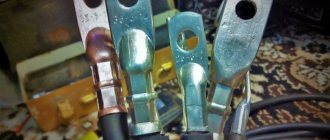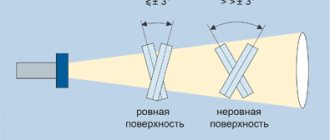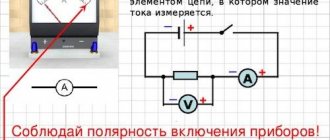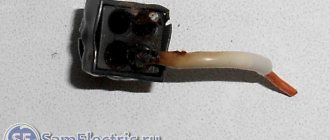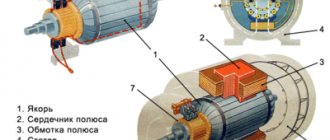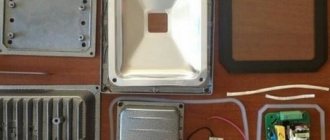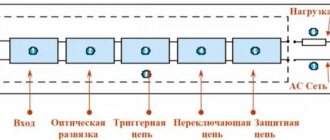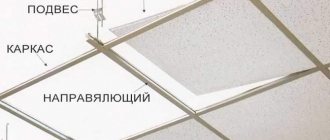Clamping wires of different sections into a common terminal
The most difficult task during installation (especially for novice craftsmen) is combining conductors of different cross-sections in one connector. To avoid problems, you should adhere to the following rules:
- Wires of larger and smaller cross-sections are diverted from each other. This can be done thanks to different insulation of the conductors, as well as a reserve in diameter at the tip skirt. The thinner product is stripped a greater distance, after which it is moved forward so that it ends up in the end first.
- At the second stage, the main wire is inserted into the tip all the way and crimping is performed.
A similar principle should be followed in the case of double NSHVIs - first the thin conductor is inserted, and then the main wires are inserted. For crimping, it is recommended to use STK-03 pliers. While working, make sure that the tool does not snap into place. To do this, hold the ratchet lever while crimping.
Types of tips
For equipment to operate efficiently, simply connecting to an electrical outlet is not enough. Another important condition is to ensure a reliable contract between the equipment and the wire. A bad connection can cause:
- overloads;
- power surges.
These situations in most cases lead to devices breaking down and requiring expensive repairs or replacement. The use of special connectors will help to avoid such problems.
The material used for their production may vary. The most common:
- Aluminum. Suitable for wires with aluminum conductors with a cross section of 16−240 mm2. For their manufacture, an AD1M aluminum pipe is used.
- Aluminum-copper. Used to connect aluminum cables to copper terminals of electrical devices. The cylindrical part of such products is made from AD1M aluminum rod, the contact part, on which the mounting hole is located, is made from M1 copper rod. Both parts are connected by frictional diffusion.
- Copper. Used for wires with copper conductors with a diameter of 2.5−240 mm2. The starting material for them is solid drawn copper pipes of grade M2 and sheets of copper grades M1 and M2.
Aluminum-copper
Aluminum-copper type lugs are combined with copper busbars of switchgears. The landing tube is made of aluminum, and copper is used for the contact blade. Two methods of manufacturing such products are used - frictional diffusion or gas-dynamic spraying. This option is characterized by ensuring strong contact.
Popular crimping tool
To install KVT tips, use the following tool:
- WS-04A is the optimal pliers for beginners. With their help, it is possible to solve the main set of problems in the process of installing various electrical circuits and assembling panels. Its functions include the ability to bite off and strip wires (cables) with a cross-section of up to 10-16 square meters. mm. In addition, it provides recesses for NShVI tips up to 6 sq. mm. (if desired, a cable up to 10 “square” is included) or up to 10 sq. mm. (includes up to 16 “square”). On sale you can find WS-04A pliers, which are equipped with dies for crimping NShVI. Their disadvantage is that the matrices can only cope with products of standard sizes up to 6 square. If you use wires with a reduced cross-section (fake), the quality of the connection will be poor.
- PKVk-10 is a universal tool that is used for crimping conductors of 0.5-10 sq. mm. But this is in theory, because in practice the situation is different. For example, to crimp a cable from 6 "square" and above, a lot of force will be required, and if you reduce the crimping force, the quality of contact when crimping connectors with a small cross-section deteriorates. The advantage of PKVk-10 is its compactness and the ability to get into even hard-to-reach places for installation (if necessary). The tool is best used for crimping conductors up to 4 square.
- STK-03 - powerful pliers that are suitable for large sections (from 10 to 25 “square”).
- PC-16. These pliers are useful for crimping TML from 6 to 10 sq. mm. The manufacturer sets the upper limit at 16 sq. mm., but in practice, crimping such a cable requires a strong hand and a lot of effort. Overall, the tool is not very good, but it has an affordable price. The PK-16u version is available for sale - a reinforced version that is more durable. The tool is suitable for cases where crimping is rarely carried out.
- PGRs-70 is a hydraulic press that is used for TML and sleeves. Many consider the tool as an alternative to PC-16. A special feature of the press is the availability of interchangeable dies with different cross-sections in the range of 4-70 sq. mm. With the help of such equipment it is convenient to crimp classic cables - six, ten or sixteen square millimeters. It does not require a lot of load or excessive effort.
- PKVsh-6 - used for crimping NShVI and NShV from 0.25 to 6 sq. mm., as well as a double tip NSHVI-2 with a cross-section from 0.5 to 4.0 sq. mm.
As for Wiedmuller or Knipex pliers, their disadvantage is the large divergence of the handles. As a result, it is difficult to crimp the NShVI with one hand (the fingers are not long enough).
To avoid discomfort when performing work, you should select a tool based on ease of use, and not focus on the brand.
Marking of wire lugs
Explanation of tip markings
Product markings differ depending on the manufacturer who specializes in the production of tips. Some of them prefer full alphanumeric markings, while others use only numeric values.
Markings and design features depend on the standard to which it was manufactured. The most popular and widespread are domestic and European standards such as GOST 23981-80, TU and din.
Letter designations:
- Types of tips: sleeve - G, ring - K, tubular - T, pin - W.
- Design: split - R, male - P, female - M.
- Additional equipment with vinyl insulation: combination VI or V.
Decoding and purpose of NSHVI
NSHVI is a type of tip, which is deciphered as follows:
- "N" - tip.
- "Ш" - pin.
- "B" - bushing.
- "I" - isolated.
This type of tip is used when crimping copper wires with a large number of cores for subsequent connection to devices and assembly of electrical circuits.
Crimping is carried out using a special tool - NSHVI crimping pliers. In other words, the task of the product is to ensure high-quality contact and integrity of the cores when connected using a screw clamp.
Sleeve NShVI are used for copper wires with a cross-section in the range of 0.5-35 sq. mm. After installation of the product, solid pins are formed at the ends of multi-core cables, simplifying connection to the terminal or equipment.
Types
Although there is a common area of application for all tips, they are all divided into many types. The most common gradation is based on the material of manufacture, the shape of the end, and the method of installation.
According to the material of manufacture
Depending on the material of manufacture, there are aluminum cable lugs. The design is made of aluminum material and allows the connection of aluminum conductors.
Aluminum
Copper lugs are made from copper and are needed to terminate copper wires and subsequently connect them to the same conductive surfaces made of tin.
Aluminum-copper are created from several materials, made of plates in different combinations. Serve to connect copper and aluminum conductors and surfaces.
Aluminum-copper
By installation method
Another criterion for separating cable terminations is the installation method. There are three types of wire lugs.
So, there is crimping using an aluminum or copper tube. This is the fastest way to install a cable lug by crimping the cable sleeve using a special tool or pliers. But, using a non-specialized tool, you can get a bad crimp connection.
For crimping
There is tightening using screw clamps. There are classic breakaway bolts. The usual ones are classic cable couplings, where the conductor is clamped with one or more bolts. Breakaways are a disposable version of a bolt clamp.
For tightening with screw clamps
Soldering and welding are the third type of cable terminations according to the installation method. Soldering of the conductor tip is carried out with tin solder. Welding is done with the same metal as the current-carrying core by spot welding.
For soldering or welding
By shape
Depending on the shape of the edge of the cable lug, cable lugs are used in different devices and perform certain functions. Based on this criterion, there are tips:
- ring - products with one part of the tube or an open ring sleeve. The ring is needed to make a clamp under the bolt and ensure good contact over the entire area.
You might be interested in Internet cable wiring
Ring
- horn with fork or hook - products, open on one side, for quickly disconnecting and connecting leads. Widely used to carry out tests.
Carob or hook
- connector - products with a classic connection.
Connector
- plate - products used to connect power cables to an electrical installation.
- plugs with sleeve tips - products placed in this connector.
- pin - models made in the form of a flat strip or a bent needle.
- tubular - elements used to splice several cores from a cable sleeve.
Each of the above types should be selected according to the tasks that need to be solved using a specific connection. But these are not the only criteria that need to be followed and used when choosing a specific model.
How to crimp NShVI bushings?
Before crimping, the wire is stripped using an insulation stripper, a special knife or a stripper. The first option is the most convenient and allows you to quickly get rid of the top insulation without damaging the cores. Stripping is carried out precisely along the length of the sleeve into which the conductor is installed.
As soon as the preparatory work is completed, a sleeve is put on the insulated part. Pre-select the pin sleeve tip (NSHVI) of the required length.
When crimping, special pliers are used, which were mentioned above.
While doing the job, it is important to know how to use press jaws. If you violate the technology, the quality of fixation leaves much to be desired
To avoid errors, the sequence should be like this:
Inserting the stripped edge into the sleeve; Installing the tip into the tool groove
It is important to ensure that the insulated part is pressed tightly against the body of the pliers; Clamping the handle with sufficient force to ensure reliable fixation of the connector.
If you do everything correctly, you get a reliable connection, and the structure itself is monolithic and strong. The principle of crimping using NSHVI-2 is similar. The main thing is to accurately select the cable cross-section. This is not difficult to do. The first numbers show the cross-section, and the subsequent ones (indicated by a hyphen) show the length of the working part.
The optimal tool for crimping in terms of price-quality ratio is considered to be the WS-04A, which was mentioned earlier. Its peculiarity is the presence of lower teeth, which ensure reliable crimping of the product. Thanks to the groove, the connector is tightly compressed and cannot be removed.
When installing the NShVI, keep one nuance in mind - use the section one step lower. What does it mean?
For example, if for a cross-module the permissible cross-section of a stranded wire is specified as 16 sq. mm., after crimping a 16mm analog using NShVI, the structure will not fit into the connector. Here you should use a 10 kV cable. mm.
The PKVK-10 tool is considered no less convenient, but it is used for smaller sections. After crimping, the connector has a rectangular, rather than trapezoidal (as in the previous case) shape.
The advantages of the tool are reliability and ease of use, but even with it there are “punctures” in the form of poor-quality crimping (this nuance should be monitored when performing work).
The nuances of working with NSHVI
If a multi-core cable is used, it is recommended to buy an NShVI tip. This type is not used for terminating wires with one core.
Crimping of a multi-core cable is performed as follows:
- you need to select the wire cross-section and tip brand. The veins should enter freely from the skirt side;
- The type of tip should be selected with some margin. A wire with a cross-section of 1.25 mm is crimped with a tip of 1.5 sq. mm, and the section of the skirt is up to 2.5 square meters. mm.
Required Tools
Crimping is carried out with a special tool that allows you to create the necessary force. The following tools are popular:
- Press pliers for crimping PK2 and PK2M lugs are used for terminating cores with a cross-section of up to 10 sq. mm;
- PK1 and PK1M brand tools are a more powerful version of hand pliers;
- hydraulic pliers allow you to crimp wires up to 10 sq. mm;
- In industrial production, a hand press is used. It is suitable for wires up to 240 sq. mm;
- hydraulic press with electric drive is used for cables up to 300 sq. mm.
Press pliers with hinges increase the pressure of the tool, which makes the manual crimping process easier. Devices with a ratcheting mechanism are especially convenient. They prevent the instrument from unclenching until the procedure is completed.
You can watch how to crimp a wire without tools in this video:
Sleeves for wires for crimping
Not all devices or instruments use cable lugs - there is also a sleeve termination. For cables with copper conductors, sleeves marked GML are used, which means tinned copper sleeve. The GAO brand is suitable for aluminum wires. This is a closed type sleeve made of aluminum. If it is necessary to make a connection with the connection of copper and aluminum elements, then an alloy is used.
Sleeves for crimping
Preparation for crimping
Before putting the tip on the core, it is necessary to perform certain preparations:
- Clean the required length of the wire from the insulation. You can use a special tool for this;
- Twist the wires by hand and place them in the tip from the skirt side.
It is important to choose the correct cross-section of the core to ensure easy entry into the tip sleeve
How to crimp a wire
After selecting suitable tips and wires, you will need a special tool. Press pliers resemble pliers, at the end of which there is a special matrix into which lugs and an uninsulated section of the cable are installed. This device ensures that the tip pressure is applied evenly on all sides.
Particular attention should be paid to the type of cable, which can be stranded or with a monolithic core
Crimping of stranded wires
Single terminal crimp
To make a high-quality crimp, it is recommended to follow the following recommendations:
- to prevent the cores from falling out of the socket, the conductor should be fixed when placed in the tool matrix;
- crimping is carried out using pliers until the snoring mechanism is activated, which allows you to block the tool from opening;
- if fixation is carried out manually, then control is carried out by pulling the hand. If the crimp is of high quality, then the installation will be tight without movement;
- You can use a double-circuit crimping tool. Termination is performed by compressing the insulator and bushing in sockets with different diameters;
- Finally, you need to check the strength of the contact by slightly pulling the elements.
Single wire crimping
Double terminal crimp
The connection of two phase conductors is carried out on one contact. When installing modular machines, they are connected using special jumpers. There are a pair of cables per contact.
In this case, it is recommended to use NShVI for two wires. Here are some installation features:
- two wires are installed inside the cuff at once;
- It is better to perform crimping using press pliers. When crimping a double tip, it is better to use a matrix with a cross section of 6 square meters. mm.
Crimping power cable lugs
To crimp the power cable, it is recommended to use a tinned copper tip, which is protected from oxidation. When cutting the cable, the edge may fluff up and become larger than the rest of the core. In this case, the edge can be removed using a sharpener. The cable should be unfolded so that the circle removes excess along the veins, but does not bend them.
You should not use the soldering method for crimping, since contacts made only with pure tin cannot be used on wires.
Power cable crimping
How to crimp a wire
After selecting suitable tips and wires, you will need a special tool. Press pliers resemble pliers, at the end of which there is a special matrix into which lugs and an uninsulated section of the cable are installed.
This device allows you to ensure even pressure from the tip on all sides. Particular attention should be paid to the type of cable, which can be multi-core or with a monolithic core.
Single terminal crimp
To make a high-quality crimp, it is recommended to follow the following recommendations:
- To prevent the cores from falling out of the socket, the conductor should be fixed when placed in the tool matrix.
- The crimping is carried out using pliers until the snoring mechanism is activated, which allows you to block the tool from opening.
- if fixation is carried out manually, then control is carried out by pulling the hand. If the crimp is of high quality, the installation will be tight without movement.
- You can use a double-circuit crimping tool. Termination is performed by compressing the insulator and bushing in sockets with different diameters.
- Finally, you need to check the strength of the contact by slightly pulling the elements.
When performing crimping for the first time, it is worth practicing on an unnecessary piece of wire. It's better to ruin one tip than the whole wire.
Double terminal crimp
The connection of two phase conductors is carried out on one contact. When installing modular machines, they are connected using special jumpers. There are a pair of cables per contact.
In this case, it is recommended to use NShVI for two wires. Here are some installation features:
- two wires are installed inside the cuff at once;
- It is better to perform crimping using press pliers. When crimping a double tip, it is better to use a matrix with a cross section of 6 square meters. mm.
Crimping power cable lugs
To crimp the power cable, it is recommended to use a tinned copper termination, which is protected from oxidation. When cutting the cable, the edge may fluff up and become larger than the rest of the core. In this case, the edge can be removed using a sharpener. The cable should be unfolded so that the circle removes excess along the veins, but does not bend them.
You should not use the soldering method for crimping, since contacts made only with pure tin cannot be used on wires.
In order not to make a mistake with the size of the tip, when going to the store, it is better to take the cable with you and select a part of the required diameter on the spot.
Popular products in Russia
There are many factories in Russia that produce NShVI tips. The leading position in this market segment is occupied by the KVT plant, which produces electrical installation tools and cable fittings of high quality and affordable prices.
Today, the plant’s product range includes more than four thousand items, which allows you to select the appropriate tools and components.
The plant produces the following products:
- Cable lugs and sleeves designed for crimping wires and cables.
- Bolted lugs and connectors - for convenient installation of cable cores. The peculiarity lies in the versatility and reliability of contact, which allows the product to be used as components for heat-shrinkable cable sleeves.
- Insulated tips, sleeves and connectors.
- Insulated clamps and terminals.
- Cable couplings KVT.
- Elements of cable couplings and other elements of equipment designed to work with wiring.
What are wire lugs for crimping used for and areas of application?
The use of cable lugs significantly increases the quality of the electrician’s work and also facilitates the procedure for connecting cables. Cables are terminated with the help of lugs and sleeves for their strong fixation. Using aluminum, copper and combined lugs, it is possible to combine power sources and different installations.
Tip and stripped wire
Tips are a universal tool. On the modern market there is a huge assortment of them, from which you can choose the necessary option for a certain type of installation work.
Different types of tips
In order to be able to select a tip for a specific cross-section, it is marked at production. If the dimensions are chosen correctly, the crimping of the cable lugs will be as reliable as possible.
Cable lugs for crimping, application
Ferrules are a universal part that provides a contact connection between a wire or cable core and the terminal of an electrical device. Their use greatly simplifies the procedure for connecting cables, and also improves the quality of the electrical circuit.
Using aluminum, copper and combined connecting parts, it is possible to switch power sources and various installations.
On the modern market there is a huge assortment of them, from which you can choose the necessary option for a certain type of electrical installation work.
In order to be able to select a lug for a specific wire cross-section, it is marked at production. If the dimensions are chosen correctly, the crimping of the connection will be as reliable as possible.
Rules for crimping: how to do it efficiently?
To get the maximum effect from using lugs, you need to crimp them correctly and thoroughly prepare the wire.
First you need to expose the veins. Ideally, this is done with a special tool - a stripper. If it is not there, then you can use improvised tools, but try to make the line as even as possible, because the quality of the insulation depends on this. The protective coating is removed 5 mm longer than the length of the shank, since during the crimping process the latter will increase in size.
Stripped copper cable
To protect against corrosion and improve contact, the exposed wire is degreased with special contact pastes.
All wires on the cut must have the same length; if this rule is neglected, the connection will not be of high quality. Some wires can break and become damaged. For the same reason, you cannot twist the wires for termination with lugs, since during the crimping process they will be crushed and will not be able to perform their functions.
Pressure testing is performed in stages. Depending on the length of the tip, 1÷2 crimps with a press may be required. For sleeves – 2÷4 pcs. They are made at a distance of 1÷2 mm. The first crimp should be at the blade, then closer to the edge of the shank.
It is necessary to select a suitable press matrix. If it is less than necessary, then large “ears” of metal will form along the edge of the crimp. After cutting them off, through holes are obtained that violate the insulation.
The tip is installed in the device so that the marking is imprinted on the front side of the element, and not on the side.
Only a small flash is allowed; here, after removing the “ears”, the insulation will be compromised
Power cable processing
For these purposes, you will need to use high-voltage wire lugs. They are made of copper with antioxidant protection. If the cable fluffs up after cutting, the edges are corrected with a sharpener. When unfolding the cable, you need to remove excess sections along the veins. It is important to avoid bending. Another caveat would be to avoid the soldering method, since contact on pure tin is not acceptable.
Read here! Zero bus - the main purpose and installation of the grounding bus. 115 photos of modern tire varieties
Video: crimping/crimping wires with various lugs and electrical installation tools
Save time: selected articles delivered to your inbox every week
Choosing the right tip allows you to save money!
Choosing the right tip allows you to save money! The table below will help you choose the size of the tip based on the cross-section of the wire. For example, when terminating a copper wire PV-1 at 95 mm 2, you need to install a T 70-10-13 tip.
| type of copper tip according to GOST 7386-80 | wire cross section | core class | type of aluminum tip according to GOST 9581-80 | wire cross section | core class |
| 2,5-(3,4,5,6)-2,6 | 2,5 | 3;4;5;6 | 16-(6,8)-5,4 | 16 | 1;2 |
| 4 | 1;2;3;4 | 25-8-7,0 | 16 | 3 | |
| 4-(4,5,6)-3 | 4 | 5 | 25 | 1;2 | |
| 6 | 1 | 35-10-8 | 25 | 3 | |
| 6-(4,5,6)-4 | 4 | 6 | 35 | 1;2 | |
| 6 | 2;3;4;5 | 50-10-9 | 35 | 3 | |
| 10 | 1 | 50 | 1 | ||
| 10-(5,6,8)-5 | 10 | 2;3;4 | 70-10-11 | 50 | 2 |
| 16 | 1 | 70 | 1;2 | ||
| 16-(6,8)-6 | 10 | 5;6 | 70-10-12 | 50 | 3 |
| 16 | 2;3 | 95 | 1 | ||
| 25 | 1 | 95-12-13 | 70 | 3 | |
| 25-(6,8)-7 | 16 | 4;5;6 | 95 | 2 | |
| 25 | 2 | 120-(12,16)-14 | 120 | 1 | |
| 35 | 1 | 150-(12,16)-16 | 95 | 3 | |
| 25-(6,8,10)-8 | 25 | 3;4;5;6 | 120 | 2 | |
| 35 | 2 | 185 | 1 | ||
| 35-(8,10)-9 | 35 | 3;4 | 150-(12,16)-17 | 120 | 4 |
| 50 | 1 | 150 | 1;2 | ||
| 35-(8,10,12)-10 | 35 | 5;6 | 185-(16,20)-18 | 185 | 2 |
| 50 | 2 | 185-(16,20)-19 | 150 | 3 | |
| 50-(8,10,12)-11 | 50 | 3;4 | 240-20-20 | 240 | 1 |
| 70 | 1;2 | 240-20-22 | 240 | 2 | |
| 50-(8,10,12)-12 | 50 | 5;6 | 300-20-24 | 185 | 3 |
| 70-(10,12)-13 | 70 | 3;4;5;6 | 240 | 3 | |
| 95 | 1 | 300 | 1;2 | ||
| 95-(10,12)-15 | 70 | 5 |
Conductor classes: 1 - single-core conductor (PV1 wire, AVVG, VVG cable) for stationary installation. 2 - multi-core conductor (wire PV2, cable AVVG, VVG) for stationary installation. 3 - stranded conductor (wire PV3, cable KGL). 4 - flexible stranded conductor (wire PV4, cable KG). 5 - flexible thin-wire conductor (PVS wire, KG cable). 6 - especially flexible thin-wire conductor (KOG cable).
Design nuances and characteristics
The NShVI tip, as a rule, has the following features:
- During the manufacturing process, M1 type copper is used;
- The upper voltage threshold is 690 V;
- The surface of the connector is subjected to electrolytic tinning;
- The dimensions of the connectors are designed to connect one cable (installation is carried out taking into account the cross-section);
- Insulation is performed using polypropylene, which does not contain halogens;
- The insulating element is characterized by high thermal resistance - it can withstand temperatures up to 105 degrees Celsius;
- KBT bushing connectors are manufactured in one color and have a common DIN standard. This is done in order to eliminate difficulties during the installation process. In addition, the color is selected taking into account the marking DIN 462228, part 4.
- The conductor is crimped on top of the copper bushing;
- The NShVI cuff has a conical shape, which eliminates problems in the process of inserting a stranded wire into the inner part of the sleeve.
Product characteristics are presented below.
Main types of lugs for crimping
There are different types of lugs for use with wires of different modifications and cross-sections. Let's look at the most popular of them:
copper tips. Used to work with copper wires. They are made from seamless tubes. On one side there is a clamping part, and on the other side there is a tubular hole for the wire. Tips of this type are used for installing electrical appliances, connecting input distribution devices and for grounding;
Copper products
aluminum. For aluminum cores, tips made of the same material are used. At one end there is a contact blade with a hole, and at the other there is a tubular hole. The cores are connected to the tip by crimping with a special tool. The product is first lubricated with quartz vaseline lubricant, which protects against oxidation;
aluminum-copper. Switchgears can use copper busbars, for which aluminum-copper lugs are suitable. In them, the landing tube is made of aluminum, and the contact blade is made of copper. Products are made using the friction diffusion method or gas-dynamic spraying method. In this case, copper sputtering covers the product on top, which allows for stable contact;
bolted These lugs are secured using a clamping bolt. In this case, crimping is not necessary, since the bolt is part of the tip. Tightening is done with a wrench.
Types for crimping
The most common and popular tips are copper, aluminum, aluminum-copper and bolted.
Copper
Copper ones are needed to carry out cable crimping, which are made from that material. To produce such parts, seamless tubes are needed. On one side of the tip product there is a clamping part. On the other connecting side there is a tubular wire hole. There are three purposes for copper lugs: to connect input and distribution devices, to make electrical devices and to insulate conductors.
Copper
NSHVI
NSHVI or pin end switches in decoding and marking are pin sleeve conductor lugs. Made from electrolytic copper with insulation. The material is processed by galvanic tinning. In everyday life and industry, such products are used for cables with a cross-section of 0.25 square millimeters. NSHVI has the advantage of saving time to connect to electrical equipment.
Note! Pin models are used for insulated copper wires that have a wide range of cross-sections. After installing the product, one-piece crimp pins are created, which simplify the moment of connection to the terminal or equipment. Capable of completely replacing the mandatory maintenance process of copper conductors. They are used in a procedure called NShVI crimping.
You may be interested in this. Features of the ShVVP cable
Pin
Homemade copper
Today there are many cable copper crimp terminations, which, in particular, are very easy to decipher. But there are cases where it is impossible to select a cable lug of the required volume. Then it is possible to use a non-standard option - to create one yourself.
The creation process is simple. To do this, you need to take a copper tube with a certain size. Next, flatten the end and make a hole with the desired diameter.
Homemade copper
Installation methods
Cable lugs are attached to wires in different ways. Most often, their installation is carried out by welding, soldering or crimping. Special installation bolts can also be used for this purpose.
The pressing method requires a special tool (press), which can be operated manually, mechanically or hydraulically, or using a pump. For installation of household contacts, a manual mechanism—a stripper—or crimping pliers is suitable. It is easy to manually attach the tip to a copper or aluminum cable used to create grounding or wiring when connecting household electrical appliances.
Crimping a power cable requires a more powerful press and can be done in three ways. The metal core is inserted into the tubular tail of the tip and compressed into the die using a punch. In certain places where the teeth of the punch are pressed in the most, the best connection between the tip and the core is ensured.
With continuous compression, the same pressure is guaranteed along the entire length of the tip. In this case, complete electrical contact between the elements is achieved. To improve the connection of the tubular part with the cable, combined crimping is used, which, under continuous crimping conditions, provides additional compression at the point where the teeth enter.
Equipment for crimping tips can vary in type of adjustable wrench or hole diameter. The standard size is considered to be a hole ranging from 0.25 to 1 millimeter.
Creating a reliable contact using a soldering iron occurs in several stages. First, the cable, stripped to a shine and treated with neutral solder, is inserted into the connector all the way, then solder is poured through a special hole.
During the installation of cable lugs using set screws, the size of their heads is controlled automatically inside the crimping apparatus. The bolts are screwed into the connector hole all the way, then their head is torn off. This ensures reliable and irreversible contact.
The advantage of bolted connections is that they can also be made without the use of a press using a wrench. The size of the connected cable may be several times smaller than the maximum diameter provided by the manufacturer for the tubular part of the tip.
Design and types
The product consists of 2 elements:
- CURRENT CONDUCTING TUBE. In the process of its manufacture, electrolytic copper with mandatory tinning is used.
- POLYAMIDE FLANGE, INSULATED.
In simple terms, NSHVI cable lugs are copper tubes processed by galvanization and having one flared end (for inserting a stranded conductor). The second part of the product is a polyamide cuff, which provides reliable insulation and protection against voltage.
During the manufacturing process, a special type of copper is used, which ensures a reliable connection at the contact point and avoids damage to the conductor due to screw pressure. Today you can buy an NShVI tip with a cross section of 0.25-150 mm.
According to the design of the device, there are two types:
- Single.
- Double.
The first are intended for crimping one, and the second - two stranded wires at the same time. This is their main advantage. For example, when power is supplied to the AB (circuit breaker), it is possible to eliminate an additional wire jumper from the circuit. Based on the characteristics of each type, the size of the plastic flange varies.
In addition to the type of product already discussed, there are other types:
- TML TIPS - used for crimping copper and aluminum cables by crimping for subsequent connection to a bus or equipment. There are two types of TMLs - copper and aluminum. The former are used to connect cables made of copper, and the latter - made of aluminum. Tinned TML products are used simultaneously with copper and aluminum conductors for crimping and soldering.
- TIPS NVI AND NKI - suitable for terminating flexible (stranded) copper conductors. Used when assembling electrical circuits when screw fixation is used during the connection process. Ring lugs are typically used to provide permanent connections to electrical equipment. If in the future it is necessary to disassemble the circuit and re-cross the clamps, it is worth using NShVI. Thanks to its use, there is no need to dismantle the fastening - just loosen the clamping screw.
Working with NShVI tips
Pin sleeve lugs are made from copper material of the electrolytic variety. The inner surface is covered with an insulating layer, and the material itself is subjected to galvanic tinning. NShVI is suitable for wires with a cross-section of more than 0.25 square meters. mm. Such products speed up work.
Who can carry out electrical work?- How to conveniently unwind a cable coil on site during electrical installation
Electrical cables. Purpose and selection criteria
NShVI lugs are suitable for multi-core cable products. Pressure testing is carried out as follows:
- choose the cross-section of the wire with the tip so that the cores easily fit in the skirt area;
- provide a reserve in cross-section - for example, for a wire of 1.25 sq. mm, crimping is carried out with a tip of 1.5 sq. mm with a skirt up to 2.5 sq. mm.
It is usually not used for single-core wires.
Labeling: how is it useful?
Each tip is marked with an alphanumeric code - this is a marking. It can provide basic information for selecting the correct electrical installation component. It looks like this: TML 70-10-11.5. Each symbol carries information:
- T is a pipe, a semi-finished product for making a part;
- M – material, in this case copper;
- L – processing method, means that this element is made of tinned copper;
- 70 (first digit of the code) – section in mm;
- 10 (second digit of the marking) – diameter of the mounting hole for the bolt in mm;
- 11.5 (third digit) is the internal diameter of the shank in mm into which the wire is inserted.
Common markings and their interpretation are presented in the table.
| Letter code | Image | Explanation and description |
| TML | Made from tinned copper, universal in use, protected from environmental influences | |
| TA | Made of aluminum, suitable for aluminum wires only | |
| THERE | Aluminum-copper for connecting aluminum wires with copper contacts | |
| SIP | Tube insulated, aluminum with copper terminal | |
| NSHVI | Sleeve pin, insulated, most applicable in everyday life |
The production of parts for electrical installation is regulated by GOST, but you can find products manufactured according to specifications or European standards; their markings will have a different appearance.
Tinned copper cable lug for crimping
Copper cable lugs for crimp testing are made from copper pipes of a certain diameter. The pipes are cut and flattened on one side. A hole of a certain diameter for a bolt is made in the flattened part. Produced at special enterprises.
- There are two types of copper cable contacts:
- uncoated cable lugs;
- with tinned coating.
Tinned contacts are considered more practical to use. Tinned coating protects the part from corrosion and extends its service life. In addition, tinned contacts are resistant to solutions of nitric, sulfuric and hydrochloric acid.
They are not afraid of exposure to air, moisture and other aggressive environmental factors. Due to the coating, the electrical conductivity of the terminals is reduced. However, it consistently maintains excellent performance.
But uncoated copper contacts will oxidize very quickly. Because of this, the conductivity indicator decreases, the resistance increases, which leads to heating of the connection.
The lugs are used for terminating cables with copper cores. For their installation, special press pliers are usually used, which are used to crimp the end onto the cable.
- Copper cable lugs for crimping are used for:
- establishing communication between the power grid and the device;
- establishing contact between devices or a group of devices;
- splicing several electrical wires to increase the length.
Main types
There are different types of lugs for use with wires of different modifications and cross-sections. Let's look at the most popular of them.
- Copper.
Used to work with copper wires. They are made from seamless tubes. On one side there is a clamping part, and on the other side there is a tubular hole for the wire. This type of product is used for installing electrical appliances, connecting input distribution devices and for grounding.
- Aluminum.
For aluminum cores, connecting parts made of the same material are used. At one end there is a contact blade with a hole, and at the other there is a tubular hole. The cores are connected to the termination using a crimping method with a special tool. The product is first lubricated with quartz vaseline lubricant, which protects against oxidation.
- Aluminum-copper.
Switchgears can use copper busbars, for which aluminum-copper terminations are suitable. In them, the landing tube is made of aluminum, and the contact blade is made of copper.
Products are made using the friction diffusion method or gas-dynamic spraying method. In this case, copper plating covers the product on top, which allows for stable contact.
- Bolted.
Fastened with a clamping bolt. In this case, crimping is not necessary, since the bolt is part of the contact connection. Tightening is done with a wrench.
Marking and decoding
The industry produces a large number of all kinds of tips, which differ in design and materials.
There is a special marking system that allows you to distinguish the material and use it for its intended purpose.
- Here is a breakdown of some of the symbols:
- A – the sleeve is made of aluminum;
- L – brass is used;
- M – the base of the product is copper;
- T – the element is made of tubular metal;
- U – the connector is made in the shape of an angle.
There is also a designation in the form of the letter O, which indicates the presence of an inspection window through which you can make sure that the cables are correctly located in the sleeve inside.
If the marking is TML (O), then it means tinned tubular copper with an inspection window. NSHVI - means a pin sleeve tip, and NKI - a ring one. In this case, the numbers indicate the cross-sectional area or diameters of the rod. To make it easier to find suitable connectors, for example, NShVI or KVT, you can use a special catalog or tables.
- After the letter designations in the markings there are usually numbers that contain information about:
- nominal section;
- diameter of the contact rod;
- internal diameter of the shank.
For example, the product is marked TML (O). This means that this wire termination is made of copper tubing and is tinned. Its distinctive feature is the presence of a small hole - an inspection window, with which you can verify whether the wire is inserted correctly for crimping.
Such contacts are used mainly in production, so not all electricians are aware of their existence.
Execution options
- There are quite a lot of tips for crimping on sale. The choice of their specific type depends on the purposes of further installation of wiring and is always the first step in the implementation of the crimping process:
- if they are to be subsequently clamped in contact blocks or circuit breakers, pin sleeve lugs are used, which in turn can be either insulated or non-insulated;
- if it is necessary to fasten the wiring under the screw nut, use special U, O and J ends, which are subsequently clamped with the same screw to the contact pad;
- Well, a big class is the male-female quick-release connections.
Today, manufacturers offer a choice of many varieties of copper cable terminations for crimping. However, there are situations when it is not possible to select the correct size cable lug. In this case, you can use a non-standard option - make such a part yourself.
The manufacturing process is not complicated. To do this, you need to take a copper tube of a certain size, flatten one end and make a hole of the required diameter.
However, the question remains open what permissible loads this handicraft product can withstand. Therefore, you should not use such a terminal in critical nodes of the electrical network.
TML cable lug
- TML (GOST 7386-80):
- Designed for terminating copper cables and wires by crimping.
- Material: electrical copper grade M2.
- Coating: electrolytic tinning (climatic version: “T2”).
- Operating voltage: up to 35 kV.
- High-quality tinning with bismuth alloying additives guarantees reliable protection of contact connections from corrosion.
- 85 items in two types of climate control.
- The shanks of the lugs according to GOST are designed for cables and wires of the 5th and 6th flexibility classes. For installation of standard copper conductors of the 2nd and 3rd flexibility classes, it is recommended to select the tip sizes according to a special table.
- Stamped marking of standard size and manufacturer's logo on each tip.
- Mandatory chamfering and tumbling operations eliminate the presence of burrs and make it easier to insert the cable core into the lug.
- After stamping, the tips are annealed to increase the ductility of the material.
